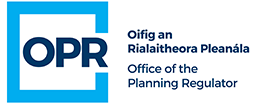The measures contained in the Waterford City and County Development Plan 2022-2028 will help the county continue to grow and become an even more attractive, prosperous, resilient and sustainable place, the Office of the Planning Regulator (OPR) has said.
In the plan adoption letter, the OPR has commended the local authority’s ambitious targets to grow Waterford City as a Regional City of Scale, by accommodating an additional population of 50%-60% by 2040 while at the same time, bringing vibrancy to Waterford’s towns and villages
The Regulator also praised the council for its clear commitment to supporting national renewable energy targets under the Climate Action Plan 2021.
This is the first time that a development plan prepared by Waterford City and County Council has been assessed by the OPR
Established on foot of the Mahon Tribunal Report, the OPR provides independent oversight of the planning system. One way the OPR does this is to independently assess the various stages of local authority plans to ensure they properly apply important national and regional government policies.
Commenting on the new Waterford City and County Development Plan, Planning Regulator, Niall Cussen said,
“Waterford City and County Council has set clear development objectives for the city and county which focuses on sustainable social, environmental, and economic growth well into the future, with an emphasis on bringing vibrancy and resilience to the county’s villages and towns.
We are particularly impressed with the manner in which the plan outlines a coherent strategy for the delivery of key national planning objectives including the promotion of compact growth1 and town and village centre regeneration.
For example, in places such as Shandon and Kilrush in Dungarvan the council has prioritised new development on sites located close to the centre. This reduces the need for people to travel and means that walking and cycling are viable options.
The plan also contains a robust renewable energy strategy, which provides for measurable renewable energy targets, demonstrates the local authority’s clear commitment to supporting national renewable energy targets under the Climate Action Plan 2021.
We are also satisfied with the manner in which the vast majority of our recommendations and observations were addressed at draft plan and material alterations stages. In some cases, while our recommendations were not fully implemented, we felt that the local authority provided good rationale for their decisions.”
In total, the OPR made 13 recommendations and nine observations on its submission at Draft Waterford City and County Development Plan stage, and four recommendations in its submission at the Material Alternations stage to the Draft Waterford City and County Development Plan.
Recommendations are made on matters considered to constitute a potential material breach of legislative or policy requirements and which may affect the co-ordination of national, regional and local planning requirements. Observations are advisory and generally issue on discretionary or more minor matters.
Planning Regulator, Niall Cussen added:
“County development plans are hugely important documents. These plans set out a vision for the future development of local areas. They decide how the provision of the homes we need will be co-ordinated with wider employment opportunities, retail activity and community facilities.
By also properly co-ordinating national, regional and local considerations in making its development plan, the members of Waterford City and County Council have taken important steps to help ensure that Waterford City and the county’s towns, villages and wider rural communities develop sustainably and are vibrant places to live and work.
I would like to put on record my sincere thanks to both the executive staff and the members of Waterford City and County Council for their engagement and hard work over long hours in preparing their development plan and at a demanding time, which included work through the pandemic.”
- Targeting a greater proportion of future development within and close to the existing ‘footprint’ of built-up areas to make best use of resources and infrastructure.
